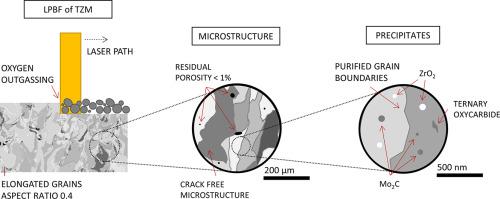International Journal of Refractory Metals & Hard Materials ( IF 3.6 ) Pub Date : 2020-08-29 , DOI: 10.1016/j.ijrmhm.2020.105369 L. Kaserer , J. Braun , J. Stajkovic , K.-H. Leitz , P. Singer , I. Letofsky-Papst , H. Kestler , G. Leichtfried

|
Molybdenum, processed by laser powder-bed fusion (LPBF), is susceptible to hot cracking because segregated oxygen impurities significantly weaken grain boundaries through the formation of MoO2. The present study reports on the LPBF processing of the most important molybdenum alloy TZM, whose alloying elements—titanium, zirconium, and carbon—lead to particle and solid solution strengthening. Results of investigations into the resulting microstructure and mechanical properties when processing TZM by LPBF are presented. The alloying elements suppress the segregation of oxygen to the grain boundaries so that crack-free samples with a density of 99.7 ± 0.3% may be produced. The microstructure shows grains that are columnar due to epitaxial grain growth and a weak 〈111〉 fiber texture parallel to the building direction. Mo2C and ZrO2 particles with a size of <50 nm are precipitated in the grain interior. Oxygen is not only bound by ZrO2. Research has shown that the ternary molybdenum‑titanium carbide, which can be found in LPBF – TZM – as is the case with pressed/sintered TZM—can dissolve oxygen. While the bending strength is 591 ± 26 MPa for samples in which only pores with a diameter of <50 μm could be detected on the fracture surface, the bending strength drops to 267 ± 50 MPa for samples with defects of 400 μm. In both cases, the fracture mode is transgranular brittle.
中文翻译:

激光粉末床熔合钼钼钛锆碳合金TZM的组织和力学性能
通过激光粉末床熔合(LPBF)处理的钼容易产生热裂纹,因为分离出的氧杂质会通过形成MoO 2显着削弱晶界。本研究报告了最重要的钼合金TZM的LPBF工艺,该合金元素钛,锆和碳可导致颗粒和固溶体强化。给出了对通过LPBF处理TZM时产生的微观结构和力学性能进行研究的结果。合金元素抑制了氧向晶界的偏析,从而可以生产出密度为99.7±0.3%的无裂纹样品。显微组织显示出由于外延晶粒的生长而呈柱状的晶粒以及平行于构造方向的弱的<111>纤维织构。尺寸小于50 nm的Mo 2 C和ZrO 2颗粒沉淀在晶粒内部。氧气不仅受ZrO 2的束缚。研究表明,在LPBF – TZM中可以发现三元碳化钼钛(与压制/烧结TZM一样)可以溶解氧气。对于在断裂表面上只能检测到直径小于50μm的孔的样品,弯曲强度为591±26 MPa,而对于缺陷为400μm的样品,弯曲强度降至267±50 MPa。在这两种情况下,骨折模式均为经晶脆性。


























 京公网安备 11010802027423号
京公网安备 11010802027423号